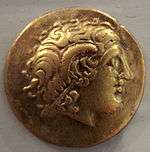Ambiani
The Ambiani (Gaulish: "the people around [the two banks of the Somme]") were a Belgic coastal tribe, dwelling in modern Picardy during the La Tène and Roman periods. They are known for their gold coinage.[1]

The Ambiani settled in the region between the 4th century BC and the Cimbri and Teutoni invasion of Gauls in the late 2nd century BC.[1] In 57 and 52 BC, they participated in Gallic coalitions against Caesar, before their eventual subjugation by the Romans in 51 BC.[2]
Name
They are mentioned as Ambianos and Ambianis by Caesar (mid-1st c. BC),[3] as Ambianoì (Ἀμβιανοὶ) by Strabo (early 1st c. AD),[4] as Ambiani by Pliny (1st c. AD),[5] as Ambianoí (Ἀμβιανοί) by Ptolemy (2nd c. AD),[6] and as Ambianenses in the Notitia Dignitatum (5th c. AD).[7][8]
The name Ambiani stems from Gaulish ambi ('around, on both sides') attached to the suffix -ani. It probably meant 'those around [the two banks of the Somme river]'.[9][10][11]
The city of Amiens, attested as civitas Ambianensium ca. 400 AD ('civitas of the Ambiani'; Ammiens in 1142, influenced by the form Ambianis), is named after the Gallic tribe.[12][8]
Geography
.jpg)
Territory
The Ambiani dwelled in the present-day department of Somme, specifically the regions of Vimeux south of the Somme river, Ponthieu to the north and Santerre to the east.[10] Their territory was bordered in the north by the Canche river, and south-east by the Somme river watershed.[2] They were located between the Bellovaci in the south, the Morini in the north, and the Viromandui in the east.[10][2]
Settlement
Their capital was Samarobriua ('bridge on the Somme river'; from Gaulish *Samara 'Somme' attached to briua 'bridge'), modern-day Amiens.[13][14]
History
The Ambiani are mentioned in thee historical classical sources: Julius Caesar's Gallic War, Livy's Summaries, and Ammianus Marcellinus' History.[15][16][17]
La Tène period
The Ambiani settled in the Picardy region between the 4th and the middle of the 2nd centuries BC.[1] At the end of the 2nd century BC, they participated in the fights against the Cimbri and Teutoni invaders.[18][1]
Gallic Wars
They are mentioned by Julius Caesar in 57 BC, who learned from his Belgic Remi informants that the Ambiani had promised to muster 10,000 armed men against the Roman armies.[19][20]
As Vercingetorix was besieged in Alesia in 52 BC, 5,000 men were asked to the Ambiani.[21][22]
Roman period
Between 386 and 450 AD, they are still mentioned by the Notitia Galliarum as living in the province of Belgica II, between the Bellovaci and the Morini.[23]
Religion
There is some evidence from coins that bear a stag on one side and a betorced head on the obverse that the Ambiani were followers of the god Cernunnos (horned God).[24]
Economy
The Ambiani were consummate minters and Ambianic coinage has been found throughout the territories of the Belgic tribes, including the Belgae of Britain.[24] Whereas other Gallic tribed imitated in general Arverni coins, themselves inspired by Phillip II of Macedon staters, Ambiani imitated coinages from Magna Graecia, in the southern part of the Italian Peninsula.[20] The first emissions of coins are thus copies of a stater minted by Taranto between 334 and 332 BC.[20]
A "monetary hegemony" over the neighbouring Parisii and Bellovaci is attested at least until the end of the 2nd century BC.[20] A few Ambiani coins have also been found along the south coast of the West Country possibly as the result of trade across the English channel.[24]

 Gold stater from the Ambiani with Celticised horse.
Gold stater from the Ambiani with Celticised horse. Ambiani stater. Stylized head.
Ambiani stater. Stylized head.
References
- Bayard & Massy 1983, p. 13.
- Schön 2006.
- Caesar. Commentarii de Bello Gallico. 2:4; 7:75
- Strabo. Geōgraphiká, 4:3:5
- Pliny. Naturalis Historia, 4:17
- Ptolemy. Geōgraphikḕ Hyphḗgēsis, 2:9:4
- Notitia Dignitatum. or 6:36; oc 9:39
- Falileyev 2010, p. entry 1828.
- Bayard & Massy 1983, pp. 16–17.
- Wightman 1985, p. 26.
- Busse 2006, p. 198.
- Nègre 1990, p. 151.
- Nègre 1990, pp. 151, 169.
- Delamarre 2003, pp. 41, 89.
- Caesar 1917, p. 2:4, 2:15, 7:77, 8:7.
- Livy 1959, p. A.U.C. 696–698.
- Ammianus Marcellinus 1950, p. 15:10.
- Caesar 1917, p. 2:4.
- C. Julius Caesar. De Bello Gallico. II:4, 15.
- Bayard & Massy 1983, p. 14.
- Caesar 1917, p. 7:77.
- Bayard & Massy 1983, p. 15.
- Bayard & Massy 1983, p. 16.
- Penhallurick, R.D (2010). Ancient and Early Medieval Coinsfrom Cornwall & Scilly (PDF). Royal Numismatic Society. p. 4. ISBN 0 901405 49 3.
Bibliography
- Bayard, Didier; Massy, Jean-Luc (1983). "Amiens romain. Samarobriva et la cité des Ambiani". Revue archéologique de Picardie. 2 (1): 13–28.CS1 maint: ref=harv (link)
- Busse, Peter E. (2006). "Belgae". In Koch, John T. (ed.). Celtic Culture: A Historical Encyclopedia. ABC-CLIO. pp. 195–200. ISBN 978-1-85109-440-0.
- Delamarre, Xavier (2003). Dictionnaire de la langue gauloise: Une approche linguistique du vieux-celtique continental (in French). Errance. ISBN 9782877723695.CS1 maint: ref=harv (link)
- Falileyev, Alexander (2010). Dictionary of Continental Celtic Place-names: A Celtic Companion to the Barrington Atlas of the Greek and Roman World. CMCS. ISBN 978-0955718236.
- Nègre, Ernest (1990). Toponymie générale de la France (in French). Librairie Droz. ISBN 978-2-600-02883-7.CS1 maint: ref=harv (link)
- Schön, Franz (2006). "Ambiani". Brill’s New Pauly.CS1 maint: ref=harv (link)
- Wightman, Edith M. (1985). Gallia Belgica. University of California Press. ISBN 978-0-520-05297-0.CS1 maint: ref=harv (link)
Primary sources
- Ammianus Marcellinus (1950). History. Loeb Classical Library. Translated by Rolfe, J. C. Harvard University Press. ISBN 978-0-674-99331-0.CS1 maint: ref=harv (link)
- Caesar, Julius (1917). The Gallic War. Loeb Classical Library. Translated by Edwards, H. J. Harvard University Press. ISBN 978-0-674-99080-7.CS1 maint: ref=harv (link)
- Livy, Julius Obsequens (1959). History of Rome. Loeb Classical Library. Translated by Schlesinger, Alfred C. Harvard University Press. ISBN 978-0-674-99445-4.CS1 maint: ref=harv (link)
Further reading
- Bayard, Didier. "Amiens/Samarobriva, Cité Des Ambiens: Aux Origines De La Ville Romaine." Gallia 72, no. 1 (2015): p. 145-60. www.jstor.org/stable/44744312.
